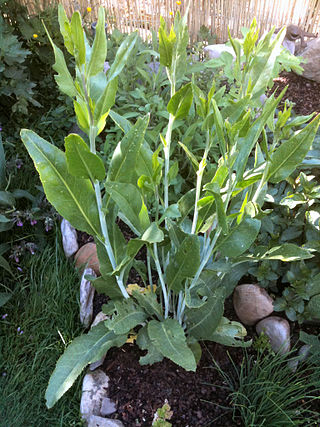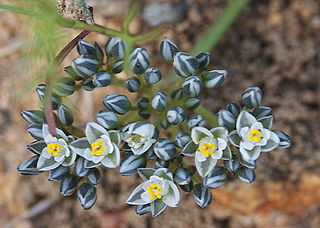
Cress, sometimes referred to as garden cress to distinguish it from similar plants also referred to as cress, is a rather fast-growing, edible herb.

Nasturtium is a genus of a small number of plant species in the family Brassicaceae commonly known as watercress or yellowcress. The best known species are the edible Nasturtium officinale and Nasturtium microphyllum. Nasturtium was previously synonymised with Rorippa, but molecular evidence supports its maintenance as a distinct genus more closely related to Cardamine than to Rorippasensu stricto.

Lepidium meyenii, known as maca or Peruvian ginseng, is an edible herbaceous biennial plant of the family Brassicaceae that is native to South America in the high Andes mountains of Peru and Bolivia. It was rediscovered for commercial purposes at the Meseta de Bombón plateau close to Lake Junin in the late 1980s. It is grown for its fleshy hypocotyl that is fused with a taproot, which is typically dried, but may also be freshly cooked as a root vegetable. As a cash crop, it is primarily exported as a powder that may be raw, or processed further as a gelatinized starch or as an extract. If dried, it may be processed into a flour for baking or as a dietary supplement.

Lepidium latifolium, known by several common names including perennial pepperweed, broadleaved pepperweed, pepperwort, or peppergrass, dittander, dittany, and tall whitetop, is a perennial plant that is a member of the mustard and cabbage family.

Lepidium is a genus of plants in the mustard/cabbage family, Brassicaceae. The genus is widely distributed in the Americas, Africa, Asia, Europe, and Australia. It includes familiar species such as garden cress, maca, and dittander. General common names include peppercress, peppergrass, pepperweed, and pepperwort. Some species form tumbleweeds. The genus name Lepidium is a Greek word meaning 'small scale', which is thought to be derived from a folk medicine usage of the plant to treat leprosy, which cause small scales on the skin. Another meaning is related to the small scale-like fruit.

Gnetum africanum is a vine gymnosperm species found natively throughout tropical Africa. Though bearing leaves, the genus Gnetum are gymnosperms, related to pine and other conifers.

Coronopus is a synonym for the accepted genus name Lepidium. It was applied to some species of flowering plants in the cabbage and mustard family Brassicaceae known commonly as swinecress or wartcress. These are generally low spreading annual herbaceous plants with many long stems, deeply lobed leaves and small white flowers. They have a strong scent, smelling like garden cress, Lepidium sativum, when crushed. Lepidium squamatus may be native to the Mediterranean but Lepidium didymum may be native to South America. Both species are widespread weedy introduced species in other areas.

Lepidium perfoliatum is a species of flowering plant in the mustard family known by the common names clasping pepperweed and perfoliate pepperwort. It is native to Europe and Asia and it can be found in other parts of the world as an introduced species.

Hornungia procumbens is a species of herb native to the temperate zone of the northern hemisphere. Common names include oval purse, slenderweed and prostrate hutchinsia.

Lepidium didymum, the lesser swine-cress, is a species of flowering plant in the family Brassicaceae.

Cyclamen africanum is a species of flowering plant in the family Primulaceae. It is referred to by the common name African cyclamen and is a perennial growing from a tuber, native to northern Algeria, Morocco and Tunisia. It is similar to Cyclamen hederifolium, but not frost-hardy.

Limeum is a genus of flowering plants. It includes 25 species.

Lepidium coronopus,, is a species of flowering plant in the mustard family which is native to parts of Africa, western Asia and Europe, growing in shingle banks, wasteland or cultivated fields.
Lepidium aretioides is a species of flowering plant belonging to the family Brassicaceae. It is a subshrub native to eastern Afghanistan.
Diplolophium is a genus of flowering plants belonging to the family Apiaceae.
Lepidium medocinense is a species of flowering plant belonging to the family Brassicaceae. It is a subshrub native to Mendoza and Neuquén provinces of northern Argentina.

Lepidium graminifolium, the grassleaf pepperweed or tall pepperwort, is a species of annual herb in the family Brassicaceae. They have a self-supporting growth form and simple, broad leaves. Flowers are visited by Ruiziella luctuosa. Individuals can grow to 51 cm tall.

Limeum africanum is a species of flowering plant in the genus Limeum. It is endemic to Southern Africa. It is also known by the names common lizardfoot and koggelmandervoet; Afrikaans for the foot of a lizard from the genus Agama.














